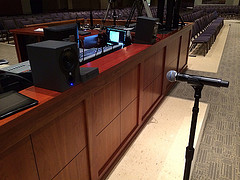
Examining Close Proximity and More
This post sort of jumps off from my last one. Last week I was doing some measurements of my vocal mics to make sure that all of my capsules were working as I’d expect.
I put pink noise in one of my nearfields at FOH and put the mics in front of the speaker. Then I checked the responses in Smaart to make sure I was getting the same results for each of the same type of vocal capsules. You can see a photo of my first test here on the right.
I noticed an interesting thing as I was testing, though. The responses I was measuring with Smaart’s RTA all looked pretty close to the manufacturer’s published frequency responses minus the smoothing they do before publishing. So then I started thinking about whether I could push the mics closer to my speaker and measure the proximity effect of each mic. Turns out I could.
I noticed some weird stuff happening in the high frequency response when I moved the mic in close, but the low frequencies behaved just as I expected. I started with a Shure Beta 58A as my control since I believe it’s the only vocal mic we use where the manufacturer has published the change in frequency response from proximity effect. Sure enough, my proximity measurement looked close enough to what Shure published so I quickly ran through our vocal mic collection to look at all of them.
So today I want to share some of the results along with some observations, but first a couple of quick notes about this little experiment. I ended up doing two measurements with each mic. The first measurement was done roughly 2 feet away from the speaker, and the second measurement was done up close to the speaker. Gain was adjusted on the console in between measurements to compensate for level changes due to distance. The measurements were then all offset in Smaart so that 1 kHz measured at 0 dB which makes the math a lot easier when you’re trying to understand how much a measurement is changing. All of the mics tested were wireless capsules on a Shure UHF-R handheld body.
Now, let’s take a look at that 58.
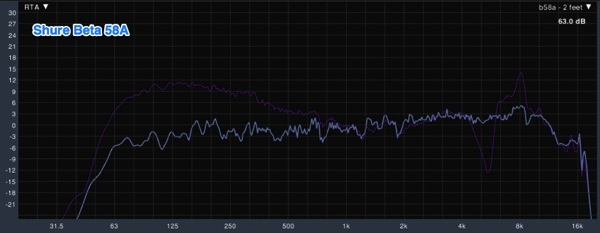
Shure Beta 58A
The image above shows my two measurements for the Beta 58A overlaid on top of each other. Ignore the weird peak and null in the 5-8 kHz range on the darker(up-close) measurement; I think that’s measurement weirdness because it showed up on all of them. But look at the low frequencies and check out the rise in level from proximity effect. It’s right around 12 dB which as I recall is what I said it looked like in Shure’s published response, but don’t take my word for it. Let’s compare:
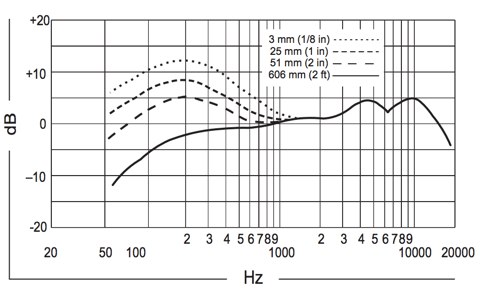
Shure Beta 58A Official Frequency Response
That’s close enough for my purposes. Who needs an anechoic chamber, anyway?
Let’s look at another one.
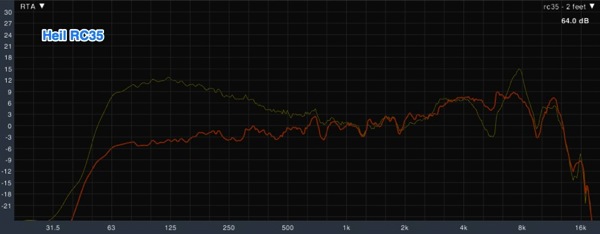
Heil RC35
Here’s a Heil RC35 capsule which is basically a PR35 which is basically a PR30. The RC35 is simply the wireless version.
You can see here that the proximity effect is similar but a little different from the Beta 58’s. What’s interesting to me about the RC35 is how big of a rise there is in the upper-mids. It looks like it’s just over 6 dB up at 4 kHz, but we’ll come back to that.
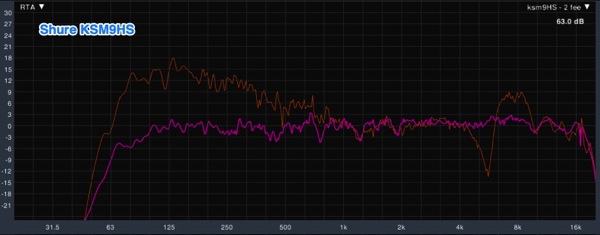
Shure KSM9HS
Next up is the latest version of Shure’s KSM9, the KSM9HS in hyper-cardioid mode. Check out how flat the response is. Now let’s compare the KSM9HS to the Heil RC35 without the proximity effect.
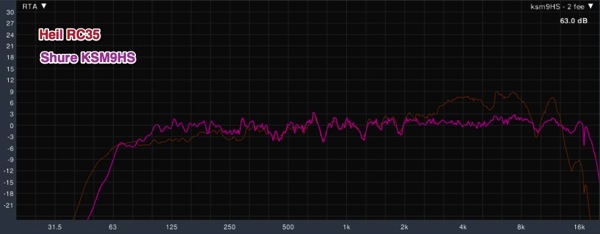
I like this image because it really explains what is going on in the Heil RC35. Personally, I like Heil mics, but I don’t think they work on everyone or everything. On the other hand, I also know a lot of engineers who aren’t fans of Bob’s mics, and I believe it’s this rise that happens in the upper-mids that bothers them.
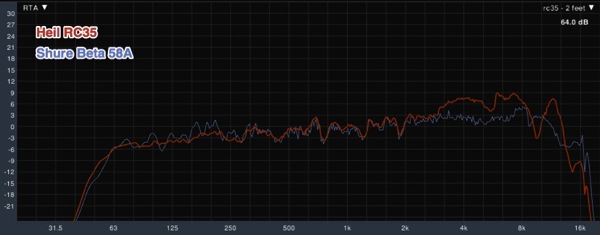
In this next image, I have the RC35 with a Shure Beta 58A. This is cool to look at because we can see that the frequency response is very similar until we get up around 3-4k. The Beta 58A still has a rise of its own in the upper-mids in that frequency area, but it’s about 3 dB down from the Heil and also peaking a little lower in frequency than the Heil. The takeaway for me from this, though, is that the Heil RC35 isn’t that far off in response from a Beta 58; it’s only around 3 dB in the upper-mids. However, the Heil certainly has much better off-axis rejection than the Beta 58; maybe I’ll measure that next time I do something like this.
Now I don’t want this post to seem like a sales pitch for Heil mics because I’m using those measurements here a lot, but I think the Heil’s response compared to the Shure responses illustrates a common trap I sometimes see engineers fall into. I’ve seen many engineers get hung up while working with unfamiliar microphones when what they normally do to that style of mic doesn’t work.
When the RC35 is the right mic for one of my vocalists, most of the time I’m just taking a little 200 Hz out. I didn’t figure that out using Smaart or some other fancy-pants analyzer. I just used my ears and turned the knob to adjust what I was hearing. The measurements shown here simply helped me make sense of what I typically do with an EQ and that particular microphone. That’s why I like measuring things; it helps it all make sense to me.
Another thing I noticed with these measurements is why I rarely do anything with an EQ on a live vocal above 1 kHz. Most of these mics have some sort of rise in their upper-mid response. Even the KSM9 has a little bump. Most live mics are already giving me some help up top so long as I clean up any proximity effect problems.
So I guess if there’s one thing you should walk away with from all this, it’s that all microphones really are different. And bear in mind these frequency measurements only illustrate one aspect of a microphone: frequency responses. There are other things that affect what we hear such as the mic’s transient response and off-axis response.
Basically, this means you can’t really use a one-size-fits-all approach on any microphone. You have to listen first, and then figure out how to make ’em work.
If you’re not a big fan of Heil mics–or any other mic for that matter–I’m not saying you’re wrong, and I’m not trying to convince you to use a specific brand. However, when you’re trying a new/unfamiliar microphone, I would encourage you to lose any preconceived ideas you might have on how to EQ or process the instrument you’re using it on and start by just listening.


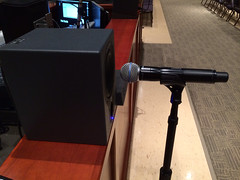
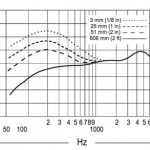 Previous Post
Previous Post



Something I think is interesting and I noticed right away. If you re-center the scale at about +6 for the Heil with proximity effect, it looks like the mic is flatter with less proximity, but with a -6 cut centered around 1.5k…
I notice that the Heil is a fair bit smoother in response in the lower frequencies, both with proximity and without.
When used for spoken word, I have found the RC35 can be prone to “s” issues. That extra boost up top explains this.
I love how the Heil gives that extra sparkle and air, like I would expect from a condenser, but doesn’t pick up anything like the cymbal and stage bleed.
I’m very keen to see your off axis measurements.
Any chance you can show a phase response chart for each?
I’ve been using a pair of PR31s on 40 person choirs, (including a 40 child choir for a church camp the other week) and getting a really smooth sound and amazing gain before feed back. The choir actually sounded just like a choir.
I’d also love to see a PR22 if you have one…?
Thanks for sharing.
Dave, if you do more tests, you might want to make a plywood(or in a pinch rigid cardboard might work) baffle of about 5′ to place the speaker in. (make a cutout that you can flush mount the speaker in, then seal the edges). That might clean up the mf anomalies you are seeing.